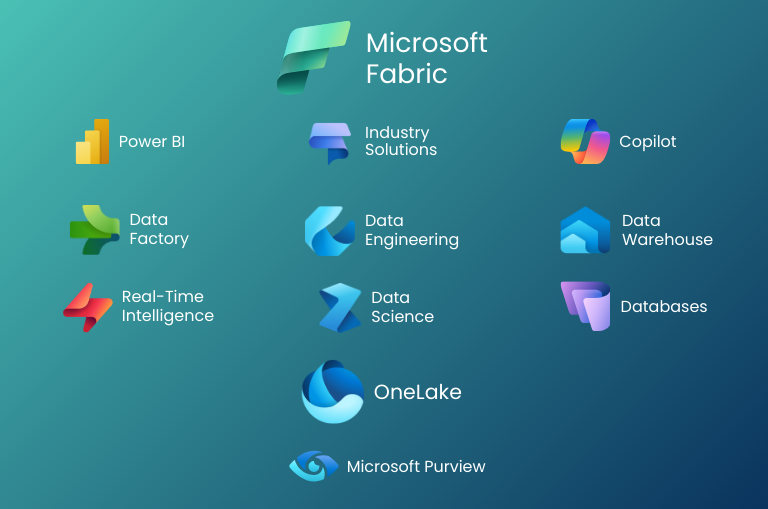Databricks vs Microsoft Fabric: Data Platform Comparison
In the era of artificial intelligence, data has gained the status of the most valuable asset of enterprises. Effectively utilising their potential requires the implementation of modern analytics platforms, including Databricks and Microsoft Fabric.
These advanced solutions enable companies to transform raw data into valuable business insights, becoming a key element of AI-driven digital transformation.
What are modern data platforms?
A modern data platform is a comprehensive solution that enables managing the entire data lifecycle from acquisition, through storage and processing, to analysis and visualisation.
Unlike traditional systems, modern platforms offer scalability, flexibility, and advanced analytics features, often leveraging the cloud as an operating environment, eliminating the need to manage physical infrastructure.
What is Databricks
Databricks is a unified, open analytics platform based on Apache Spark, created by the original developers of this system. It enables processing large datasets, advanced analytics, and creating AI solutions at scale.
Databricks introduced the data architecture and concept of the Data Lakehouse, combining the advantages of a Data Warehouse and a Data Lake in one solution.
The Databricks architecture is based on Delta Lake, an open data storage format providing ACID transactions, MLflow for managing ML models, and Apache Spark for data processing.
Thanks to integration with Apache Spark, Databricks enables real-time processing of large datasets, which is crucial for business analytics and decision-making processes.
Strengths
The strengths of Databricks are efficient large-scale data processing with Apache Spark, advanced machine learning capabilities with MLflow, multi-cloud flexibility, support for ACID transactions with Delta Lake, an open architecture enabling integration with various tools, as well as the maturity and stability of a platform proven by industry leaders.
Weaknesses
Databricks requires significant technical knowledge and programming skills, which is a barrier for less technical users. The platform can be costly at large scale, offers a less intuitive interface compared to Microsoft solutions, and requires additional work to integrate with tools outside the Databricks ecosystem.
Integrations
Databricks integrates with popular cloud services (Azure, AWS, GCP), data storage solutions (ADLS, S3, Google Cloud Storage), and BI tools (Tableau, Power BI). It also supports various data formats, programming languages (Python, SQL, R, Scala), and ML frameworks, offering an open API that allows connection to almost any external system.
AI and Machine Learning
Databricks provides a complete environment for AI/ML projects with tools such as MLflow for model lifecycle management, support for popular ML libraries and frameworks, and a collaborative workspace for data scientists. The platform offers efficient data processing with Apache Spark, advanced versioning and experiment monitoring features, and scalability needed for training complex models.
Pricing model
Databricks offers a pay-as-you-go pricing model with no upfront costs. You only pay for the products you use, billed per second. Committed Use Contracts are also available, offering significant discounts in exchange for a commitment to a specific usage level, with flexibility across multiple clouds.
When to choose Databricks?
When selecting a platform and analytics tools, consider Databricks if your company needs advanced capabilities for processing large datasets and machine learning.
It is ideal for organisations with data science teams, requiring multi-cloud flexibility, detailed infrastructure control, and an open architecture enabling integration with diverse systems and tools.
What is Microsoft Fabric
Microsoft Fabric is a comprehensive analytics and data platform that combines various tools in one environment. Based on SaaS architecture, it integrates components such as Data Factory, Data Engineering, Data Warehouse, and Power BI.
Its central element is OneLake, a unified data repository. Fabric offers built-in AI features, including Microsoft Copilot, enabling task automation and intelligent analytics generation.

Microsoft Fabric is based on SaaS architecture with OneLake at its core, eliminating data silos. The platform combines all data workloads from data engineering, through warehousing, to real-time analytics.
Benefits include centralised data management, seamless integration with the Microsoft ecosystem, built-in AI features, and a medallion architecture (bronze-silver-gold) supporting data processing from raw to advanced analytics.
See the Microsoft Fabric business guide.
Strengths
Microsoft Fabric stands out for its comprehensive integration of all aspects of data analytics in a single platform. A key advantage is OneLake, the unified repository, by eliminating data silos. Fabric offers a wide range of analytics tools tailored to different roles in the organisation. Native integration with the Microsoft ecosystem (Power BI, Azure, Microsoft 365) ensures smooth workflows. Built-in AI features, including Microsoft Copilot, automate tasks and provide intelligent insights. Fabric also enables comprehensive data management with access control and regulatory compliance.
Weaknesses and limitations
Despite its comprehensive nature, Microsoft Fabric has its limitations. The platform is tightly linked to the Microsoft ecosystem, which can make integration with other vendors' solutions more difficult. Fabric is a relatively new product, so it has less mature functionalities compared to specialised tools. Multi-cloud flexibility is mainly limited to Azure. The capacity model may be less flexible for organisations with fluctuating computing needs. Additionally, the platform's complexity can extend the learning curve for new users.
Integrations
Microsoft Fabric offers native integration with the entire Microsoft ecosystem, including Microsoft 365, Microsoft Azure, Microsoft Copilot Studio, and Microsoft Power Platform. It also has numerous connectors to external systems, including Snowflake, Google BigQuery, MongoDB, and AWS S3. With Data Factory, Fabric can pull data from various structured and unstructured sources. Integration with Power BI provides advanced visualisation capabilities, while connection with Microsoft Azure AI Foundry enables the use of advanced AI features.
AI and Machine Learning
Microsoft Fabric offers advanced AI capabilities through integration with Azure Machine Learning in Microsoft Azure AI Foundry and Microsoft 365 Copilot. The platform allows creating, deploying, and managing ML models in a unified environment without switching between tools. AI features are embedded throughout the data lifecycle, from engineering to business analysis. Fabric automates routine tasks, generates quick reports, and builds auto-models, making it a good choice for companies seeking integrated AI experiences.
Pricing model
Microsoft Fabric offers two main pricing models: Pay-as-you-go (flexible, no commitments) and Reserved (with savings up to 40% for annual reservations). Costs depend on two main factors: compute and storage. A single compute resource can handle all functions simultaneously and be shared across multiple projects. Fabric also offers three types of user licenses: Free, Pro, and Premium per-user.
See the Microsoft Fabric licensing and pricing guide
When to choose the Microsoft Fabric data platform?
Microsoft Fabric will be the optimal choice for organisations already using the Microsoft ecosystem. It works well for companies seeking a comprehensive solution covering the entire data lifecycle from acquisition to visualisation. It is ideal for enterprises needing integration of different teams (data engineers, analysts, data scientists) on a single platform.
Fabric is also suitable for organisations that want to leverage advanced AI features without building complex infrastructure, using built-in tools powered by Microsoft Copilot.
What is the difference between Databricks and Microsoft Fabric
The main differences between Databricks and Microsoft Fabric concern the deployment model, ecosystem integration, and specialisation.
Databricks is a PaaS (Platform as a Service) offering detailed infrastructure control, ideal for advanced analytics and ML tasks. It runs on multiple clouds (Azure, AWS, GCP) and is considered more mature, but requires more technical expertise.
Microsoft Fabric is a SaaS (Software as a Service) solution managed by Microsoft, requiring no infrastructure configuration. It is tightly integrated with Microsoft products, offers a user-friendly interface with no-code/low-code features, and centralises data in OneLake. Fabric is easier to use for less technical users, but is limited to the Microsoft Azure ecosystem.
The choice between them depends on the existing infrastructure, specific analytics needs, and the organisation's integration preferences.
Which system to choose for a company?
Small company
For a small company, the key factor is ease of implementation and minimising administrative costs.
For a small company, Microsoft Fabric will usually be a better choice due to its lower entry threshold, more straightforward operation without a dedicated IT team, and more favourable initial costs. However, if the company specialises in data analysis or AI and has technical expertise, Databricks can provide greater flexibility and scalability in the long term.
Medium company
A medium-sized company should base its choice on the existing IT infrastructure and specific analytics needs.
Medium companies should base their choice on the existing technology ecosystem and available expertise. If the organisation mainly uses Microsoft products and has limited technical resources, Fabric will provide faster implementation and easier management. If the priority is advanced analytics and machine learning, Databricks may offer greater growth potential.
Large company
Large enterprises should make their choice based on IT strategy, existing investments, and a long-term vision for data management.
Large companies may consider a hybrid approach, implementing both solutions for different use cases. Databricks works well for advanced analytics scenarios, machine learning, and processing massive amounts of data, while Microsoft Fabric can be used to create business dashboards, reporting, and visualisation for non-technical users within the Microsoft ecosystem.
Summary
Choosing between Databricks and Microsoft Fabric is a strategic decision that should take into account the existing technology ecosystem, team expertise, business specifics, and the organisation's long-term goals. Databricks is suitable for companies needing advanced analytics, Big Data processing, and machine learning capabilities, especially with an experienced technical team and in a multi-cloud environment.
Implementing Microsoft Fabric will be a better choice for organisations integrated with the Microsoft ecosystem, valuing ease of implementation, a unified environment, and ease of use without infrastructure management.
For large organisations, a hybrid approach leveraging the advantages of both platforms in different scenarios may be optimal.

